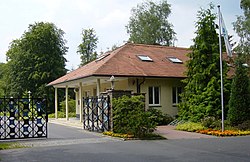
East Germany is the common English name for the historical German state known as the German Democratic Republic (GDR) located in Central Europe from its formation on 7 October 1949 until its reunification with West Germany on 3 October 1990. Until 1989, it was generally viewed as a communist state and described itself as a socialist "workers' and peasants' state". The economy of this country was centrally planned and state-owned. Although the GDR had to pay substantial war reparations to the Soviets, it became the most successful economy in the Eastern Bloc.

Erich Fritz Emil Mielke was a German communist official who served as head of the East German Ministry for State Security, better known as the Stasi, from 1957 until shortly after the fall of the Berlin Wall in 1989.
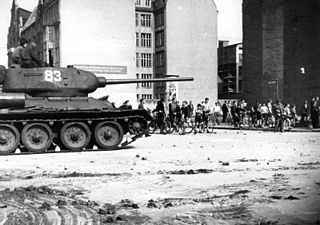
The East German uprising of 1953 was an uprising that occurred in East Germany from 16 to 17 June 1953. It began with strike action by construction workers in East Berlin on 16 June against work quotas during the Sovietization process in East Germany. Demonstrations in East Berlin turned into a widespread uprising against the Government of East Germany and the Socialist Unity Party the next day, involving over one million people in about 700 localities across the country. Protests against declining living standards and unpopular Sovietization policies led to a wave of strikes and protests that were not easily brought under control and threatened to overthrow the East German government. The uprising in East Berlin was violently suppressed by tanks of the Soviet forces in Germany and the Kasernierte Volkspolizei. Demonstrations continued in over 500 towns and villages for several more days before eventually dying out.
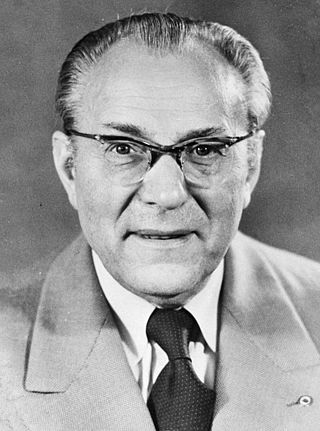
Otto Emil Franz Grotewohl was a German politician who served as the first prime minister of the German Democratic Republic from its foundation in October 1949 until his death in September 1964.

The Free German Trade Union Federation was the sole national trade union centre of the German Democratic Republic which existed from 1946 to 1990. As a mass organisation of the GDR, nominally representing all workers, the FDGB was a constituent member of the National Front. The leaders of the FDGB were also senior members of the ruling Socialist Unity Party of Germany (SED).

The National People's Army were the armed forces of the German Democratic Republic (GDR) from 1956 to 1990.

The Peaceful Revolution, as a part of the Revolutions of 1989, was the process of sociopolitical change that led to the opening of East Germany's borders with the West, the end of the ruling of the Socialist Unity Party of Germany (SED) in the German Democratic Republic in 1989 and the transition to a parliamentary democracy, which later enabled the reunification of Germany in October 1990. This happened through non-violent initiatives and demonstrations. This period of change is referred to in German as Die Wende.

The inner German border was the frontier between the German Democratic Republic and the Federal Republic of Germany from 1949 to 1990. De jure not including the similar but physically separate Berlin Wall, the border was 1,381 kilometres (858 mi) long and ran from the Baltic Sea to Czechoslovakia.

The Felix Dzerzhinsky Guards Regiment was the paramilitary wing of the Ministry for State Security (Stasi), the security service of the German Democratic Republic (GDR).

Wandlitz is a municipality in the district of Barnim, in Brandenburg, Germany. It is situated 25 km north of Berlin, and 15 km east of Oranienburg. The municipality was established in 2004 by merger of the nine villages Basdorf, Klosterfelde, Lanke, Prenden, Schönerlinde, Schönwalde, Stolzenhagen, Wandlitz and Zerpenschleuse.

The Majakowskiring is an ellipse-shaped street in the Pankow district of Berlin, Germany, in the Niederschönhausen locality. It was famous as the residence of many senior figures in the government of the German Democratic Republic.
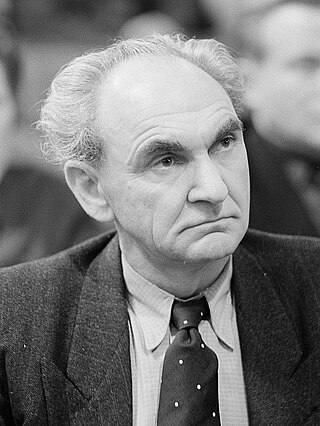
Heinrich Gottlob "Heiner" Rau was a German communist politician during the time of the Weimar Republic; subsequently, during the Spanish Civil War, he was a leading member of the International Brigades and after World War II a leading East German statesman.
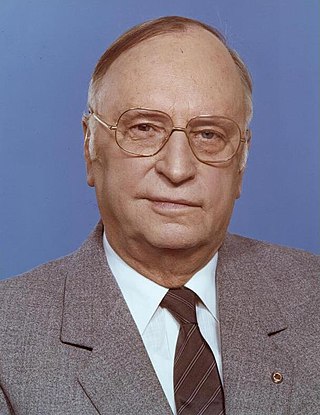
Kurt Hager was an East German statesman, a member of the Socialist Unity Party of Germany who was known as the chief ideologist of the party and decided many cultural and educational policies in the German Democratic Republic.
The Stasi Records Agency was the organisation that administered the archives of Ministry of State Security (Stasi) of the former German Democratic Republic. It was a government agency of the Federal Republic of Germany. It was established when the Stasi Records Act came into force on 29 December 1991. Formally it was called the Federal Commissioner for the Records of the State Security Service of the former German Democratic Republic ; the official German abbreviation was BStU. On June 17, 2021, the BStU was absorbed into the German Federal Archives (Bundesarchiv).

Vera Lengsfeld is a German politician. She was a prominent civil rights activist in East Germany and after the German reunification she first represented the Alliance 90/The Greens and then the German Christian Democratic Union (CDU) in the Bundestag.

Niederschönhausen is a locality (Ortsteil) within the borough (Bezirk) of Pankow in Berlin, Germany. It is also known as "Pankow-Schönhausen" to differ it from Hohenschönhausen in Berlin-Lichtenberg. From 1949 until 1960 Schönhausen Palace and the adjacent Majakowskiring quarter were the residence of several members of the East German government, commonly referred to as Pankow by the West German media.
Zersetzung was a psychological warfare technique used by the Ministry for State Security (Stasi) to repress political opponents in East Germany during the 1970s and 1980s. Zersetzung served to combat alleged and actual dissidents through covert means, using secret methods of abusive control and psychological manipulation to prevent anti-government activities. People were commonly targeted on a pre-emptive and preventive basis, to limit or stop activities of dissent that they may have gone on to perform, and not on the basis of crimes they had actually committed. Zersetzung methods were designed to break down, undermine, and paralyze people behind "a facade of social normality" in a form of "silent repression".

Helmut Müller-Enbergs is a German political scientist who has written extensively on the Stasi and related aspects of the German Democratic Republic's history.
Bernhard Elsner was a Major general in the East German Ministry for State Security (Stasi). During the course of a long career with the quasi-military ministry, between 1972 and 1987 he was Commander of the Felix Dzerzhinsky Guards Regiment.

Hans Albrecht was a German politician and high-ranking party functionary of the Socialist Unity Party (SED).
